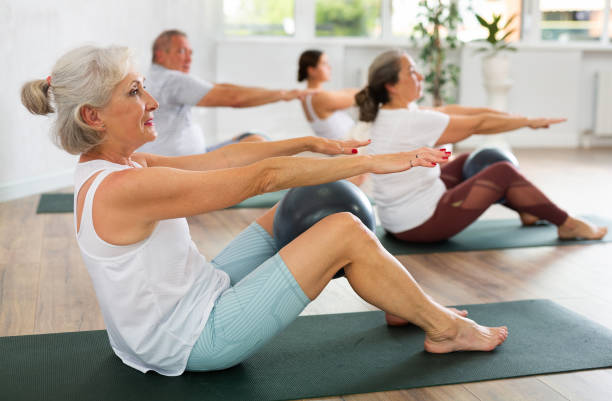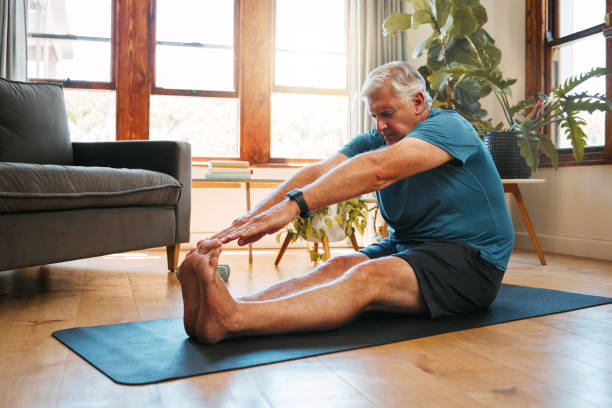As we age, our bodies undergo significant changes that can impact our mobility, flexibility, and overall quality of life. These changes often include decreased muscle mass, reduced joint flexibility, and decreased balance and coordination. However, integrating stretching exercises into our daily routine can be a powerful tool to counteract these age-related declines. Stretching not only enhances flexibility and mobility but also plays a crucial role in injury prevention, pain reduction, and the maintenance of a healthy, active lifestyle well into our later years.
By dedicating time to stretch regularly, aging individuals can significantly improve their physical health, ensuring that they continue to enjoy a wide range of activities with greater ease and less discomfort.
Contents
The Benefits of Regular Stretching for Seniors

Among the myriad ways to maintain physical well-being as we age, stretching exercises stand out for their simplicity and effectiveness. This gentle form of physical activity is accessible to nearly everyone and requires no special equipment, making it an ideal option for seniors seeking to enhance their health and mobility. Regular stretching offers a foundation upon which individuals can build a healthier, more active lifestyle, highlighting its significance as an indispensable part of an overall fitness regimen for the aging population.
Improved Flexibility and Range of Motion
Regular stretching exercises can markedly improve flexibility and the range of motion in joints for aging individuals. This enhanced flexibility is crucial in easily performing daily activities, such as bending, reaching, or twisting movements, thus promoting a more independent lifestyle.
Enhanced Muscular Strength and Posture
Stretching also plays a pivotal role in strengthening muscles and improving posture. Although it might not build muscle in the same way resistance training does, it helps maintain muscle tone and prevent muscle atrophy that often accompanies aging. Improved posture, a direct benefit of strengthened muscles, can also help reduce back and neck pain, contributing to a better quality of life.
Increased Circulation and Stress Reduction
Engaging in regular stretching exercises has been shown to increase blood flow to the muscles, delivering essential nutrients while flushing out toxins. This increased circulation can aid in the faster recovery of muscles and reduce soreness. Additionally, stretching has a calming effect on the mind, serving as a stress-relief activity that enhances mental health.
Enhanced Balance and Coordination
As balance and coordination decline with age, incorporating stretching exercises that focus on these areas can significantly reduce the risk of falls, a common cause of serious injury among seniors. Exercises that improve balance and coordination help in maintaining independence and the ability to perform activities of daily living safely and efficiently.
Establishing a Stretching Routine for Seniors
Creating a safe and effective stretching routine is paramount for seniors looking to reap the many health benefits of stretching. Several key factors must be considered to ensure the routine caters to the unique needs of the aging population.
Personalizing Your Stretching Routine
Tailoring the stretching routine to individual capabilities and health conditions is crucial. It’s important for seniors to consult with healthcare providers or physical therapists to devise a routine that fits their specific health status and fitness level. Incorporating stretches that target areas needing the most attention can maximize benefits.
Safe Stretching Practices
Safety should always be a priority when it comes to physical activities for seniors. Warm-up exercises before stretching can prepare the body and reduce the risk of injury. Focusing on smooth, steady movements and avoiding bouncing or abrupt motions during stretches can ensure safety. It’s vital for seniors to listen to their bodies and avoid pushing beyond comfort levels to prevent strains.
Consistency and Duration
For stretching to be truly effective, consistency is key. A regular stretching routine, ideally performed daily, can help seniors maintain and gradually improve their flexibility and mobility. The duration of each stretching session can vary, but aiming for a total of 10 to 15 minutes per day can provide significant benefits without overwhelming the individual.
Incorporating a Variety of Stretching Techniques
Various stretching techniques, including static, dynamic, and proprioceptive neuromuscular facilitation (PNF), offer unique benefits. Static stretches involve holding a stretch for a prolonged period, typically 15-30 seconds, which is ideal for improving flexibility.
Dynamic stretches, which involve gentle movements where the stretch is not held, can be beneficial in warming up the body before more intense activity. PNF stretches, which require the help of a partner or physical therapist, can further improve flexibility and muscular strength. Variety of stretching techniques can keep the routine engaging and address different physical needs.
Conclusion
Incorporating regular stretching exercises into daily routines can offer seniors a wide range of benefits, including improved flexibility, posture, balance, and overall physical and mental well-being. By personalizing the routine to individual capabilities and health conditions, practicing safe stretching techniques, maintaining consistency, and incorporating a variety of stretches, aging individuals can significantly enhance their quality of life. Ultimately, stretching is a simple yet powerful tool for promoting healthy aging and maintaining an active lifestyle.
